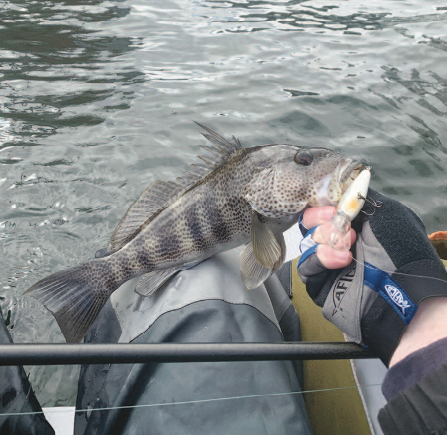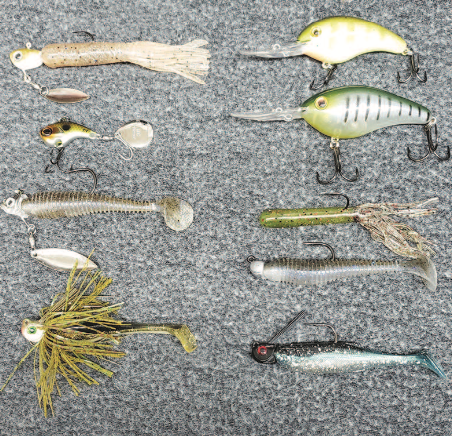
Despite water temperatures dipping below 60 degrees across SoCal, saltwater bass anglers can still find some solid action across the bays, harbors and breakwater structure, provided they pay attention to bait choice and technique. Here’s what you need to know to get hooked up on any of the saltwater bass species this winter.
Crankbaits worked deep
Believe it or not, crankbaits are a great way to catch a lot of quality bay bass at this time of year. Even though the water is cold and the sluggish fish aren’t going to chase lures as well as when the water is warmer, a well-placed crank can draw some vicious strikes. A couple of keys to w1inter cranking is us- ing a bait that gets to the bot- tom. Don’t be afraid to throw a bait that literally digs into the mud. I like to fish a bait that dives 15 feet in water that is 10 to 12 feet deep. The key to get- ting bit is to pause the bait near likely ambush spots and let it pop out of the muddy water for a split second. Second, make multiple casts to likely holding areas. I can’t tell you how many fish I have caught on my fifth or sixth cast down the same dock lane.
Swimbaits low and slow
Swimbaits are a staple all year in the bay. Brands like Big Ham- mer, MC, Pearl, Keitech, Reyes and many o2thers will work dur- ing cold water periods. This time of year, most of the baitfish are a bit larger and as such, I don’t think it’s as crucial to match the hatch. I tend to think of swim- baits more in terms of drag baits. Low and slow right on the bot-
tom rather than swimming off the bottom is key. Focus on your bait as it falls, a lot of bites occur just as the bait reaches the bot- tom. In terms of color, I prefer darker crab and shrimp-like col- ors this time of year. On bright sunny days or when the water is clear, lighter baitfish colors do the trick.
Swimjigs and under- spins over grass
When it comes to fishing grass, few baits can compete this time of year with swimjigs and underspins. Again, low and slow through the grass is the way to go. The key here is a good weed- less bait like those made by WARBAITS. Having a bait with the line tie3d on the nose helps to reduce the amount of grass that it snags. Also, use the lightest head that you can to help you walk the lure through the grass strands. I like to fish 1/4- to 3/8- ounce baits. In addition, I have found fishing these lighter lures on a spinning rod with 15- to 20- pound braid and a 10- to 12- pound fluorocarbon leader works well. For areas with no grass, feel free to up the weight of these lures from 1/2-ounce to 3/4-ounce. You can bomb long casts and slow roll the bait along the bottom, focusing in getting the bait to stay within a few inches of the bottom.
Tube baits for on- the-drop hits

I have been fishing tube baits for spotties for almost 30 years. Growing up back East, I was very familiar with fish tubes for smallmouth bass. When I moved to SoCal in the mid-’80s and started fishing for bay bass, I quickly found out that these freshwater baits worked really well in our local bays. Tubes are most effective when fished as a drop bait. The way they fall with a spiral motion on a slack line can generate some epic bites. In the last few years this bait has gained a lot of popularity with the introduction of Hookup Baits. It is important to fish these baits with as light a jig head as possible. The last thing you want is for your tube to missile straight to the bottom. I have found that I prefer 3/16-ounce to 1/4-ounce heads for shallower water and 3/8- to 1/2-ounce for deep water. I like to fish tube baits on medium spinning gear with 15- to 20- pound braid and 10- to 12- pound leader. To me this is structure fishing at its best — try to get your bait to fall near likely holding spots like docks and the edges of weed beds.
Water clarity and bait choices
As you fish the bay, always look for tw5o key things: moving water and off-colored water. You can debate whether an incoming tide is better than an outgoing tide all day and to me, it re- ally doesn’t matter. What is important is to fish when you have moving water — your chances of having a good day in the wintertime increase dramatically if you fish during a good tidal flow.
Water clarity is the next big thing to consider. If you can see the bottom in 15 feet of water, then chances are the fish can see you, as well as your line. If you find clear water conditions, spend the time to look around and search out the most off-color water you can find. Even a bit of turbidity in the water will greatly enhance your chances of drawing strikes. If the whole bay is gin clear, what I tend to do is back off the structure much further and switch over to crankbaits or underspins. You can make long casts with these lures and the bass’ instincts to attack these types of reaction baits overcomes their inhibitions caused by the clear water.
Lastly, I just want to take this opportunity to talk about fish handling. Spotted bay bass fishing has exploded in popularity over the last 10 to 15 years.
Heck, 30 years ago you were lucky to see three or four boats fishing in Newport Bay on a summer’s day and float tubes and kayaks didn’t even exist. Now, even in the wintertime, the bays see more and more fishing pressure. The advent of the internet and cell phone cameras now make it simple, and to a lot of people mandatory, to take pictures of all their fish, and that’s fine. I just want to stress that we need to handle these fish carefully and get them back into the water as quickly as possible.
If at all possible, don’t lay the fish on the deck of your boat, or on a dock or in the sand. It’s best if you don’t touch the fish’s body at all if possible. If possible, it’s best if you lip them remove the hook, snap a photo and slide them back into the water. The less stress we put on the fish, the more they will survive to be caught again and again. So, enjoy fishing the quiet time in the bay, I hope these tips help you catch more fish.


